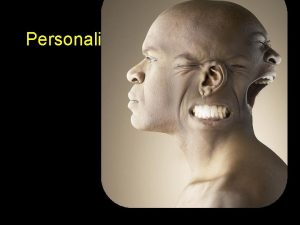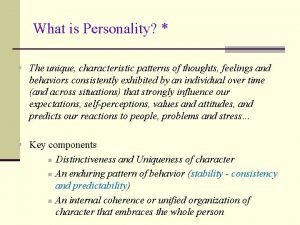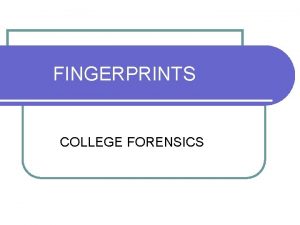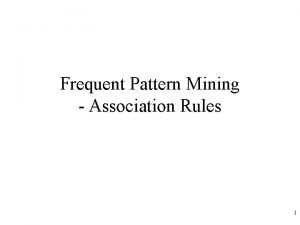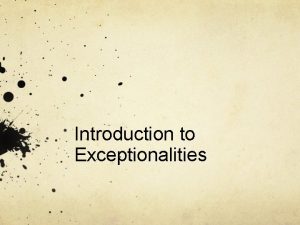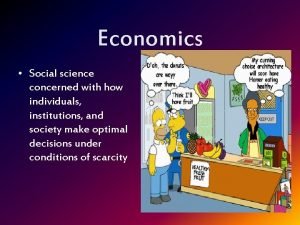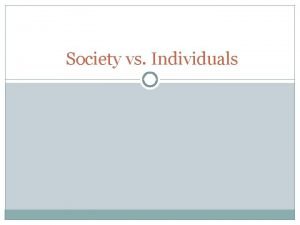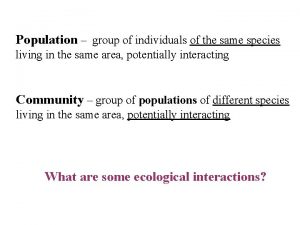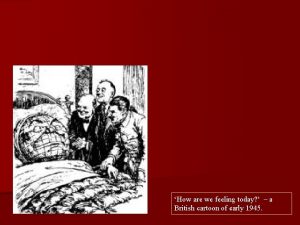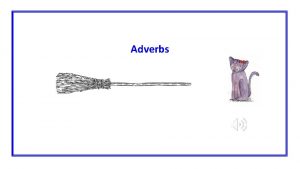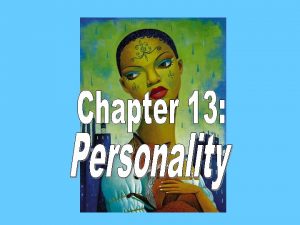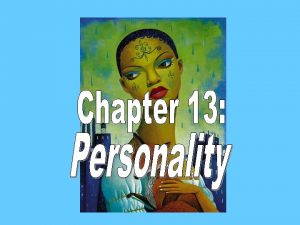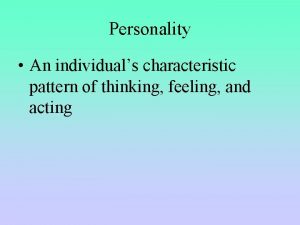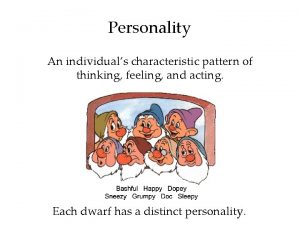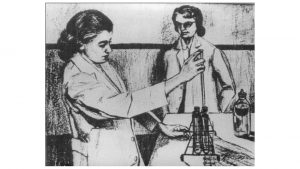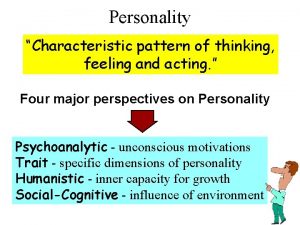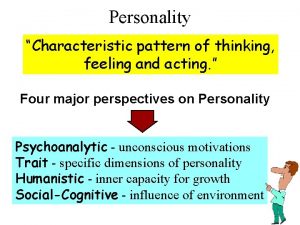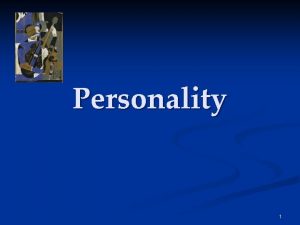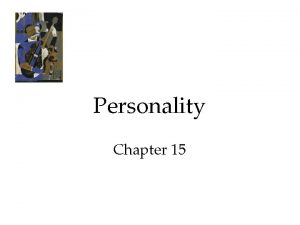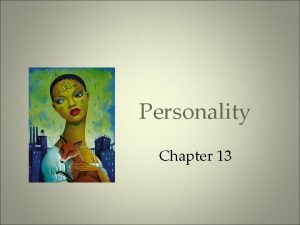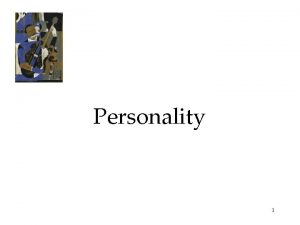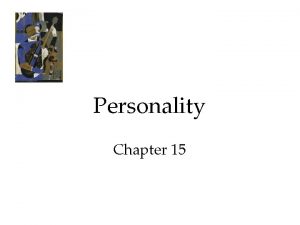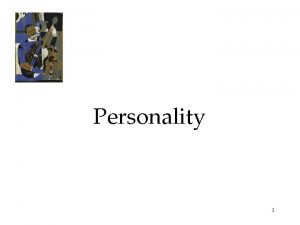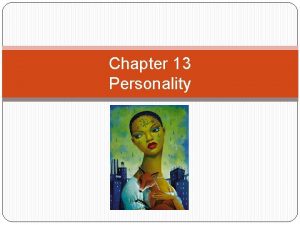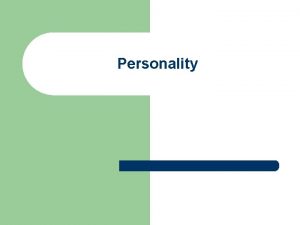Personality An individuals characteristic pattern of thinking feeling

























































- Slides: 57

Personality An individual’s characteristic pattern of thinking, feeling, and acting. Each dwarf has a distinct personality.

Psychoanalytic Perspective Culver Pictures In his clinical practice, Freud encountered patients suffering from nervous disorders. Their complaints could not be explained in terms of purely physical causes. Sigmund Freud (1856 -1939)

Psychodynamic Perspective Culver Pictures Freud’s clinical experience led him to develop the first comprehensive theory of personality, which included the unconscious mind, psychosexual stages, and defense mechanisms. Sigmund Freud (1856 -1939)

Exploring the Unconscious A reservoir (unconscious mind) of mostly unacceptable thoughts, wishes, feelings, and memories. Freud asked patients to say whatever came to their minds (free association) in order to tap the unconscious. http: //www. english. upenn. edu

Dream Analysis Another method to analyze the unconscious mind is through interpreting manifest and latent contents of dreams. The Nightmare, Henry Fuseli (1791) Manifest: incorporates traces of previous days’ experiences and preoccupations Latent: unconscious drives and wishes that would be threatening if expressed directly

Psychoanalysis The process of free association (chain of thoughts) leads to painful, embarrassing unconscious memories. Once these memories are retrieved and released (treatment: psychoanalysis) the patient feels better.

Model of Mind The mind is like an iceberg. It is mostly hidden, and below the surface lies the unconscious mind. The preconscious stores temporary memories.

Personality Structure Personality develops as a result of our efforts to resolve conflicts between our biological impulses (id) and social restraints (superego).

Id, Ego and Superego The ego functions as the “executive” and mediates the demands of the id and superego. The Id unconsciously strives to satisfy basic sexual and aggressive drives, operating on the pleasure principle, demanding immediate gratification. The superego provides standards for judgment (the conscience) and for future aspirations.


Personality Development Freud believed that personality formed during the first few years of life divided into psychosexual stages, During which the id’s pleasure-seeking energies focus on pleasure sensitive body areas called erogenous zones.

Oedipus Complex A boy’s sexual desire for his mother and feelings of jealousy and hatred for the rival father. A girl’s desire for her father is called the Electra complex.

Identification From the K. Vandervelde private collection Children cope with threatening feelings by repressing them and by identifying with the rival parent. Through this process of identification, their superego gains strength that incorporates their parents’ values.

Defense Mechanisms The ego’s protective methods of reducing anxiety by unconsciously distorting reality. 1. Repression banishes anxiety-arousing thoughts, feelings, and memories from consciousness. 2. Regression leads an individual faced with anxiety to retreat to a more infantile psychosexual stage.

3. Reaction Formation causes the ego to unconsciously switch unacceptable impulses into their opposites. 4. Projection leads people to disguise their own threatening impulses by attributing them to others.

5. Rationalization offers selfjustifying explanations in place of the real, more threatening, unconscious reasons for one’s actions. 6. Displacement shifts sexual or aggressive impulses toward a more acceptable or less threatening object or person, redirecting anger toward a safer outlet.



The Neo-Freudians National Library of Medicine Like Freud, Adler believed in childhood tensions. However, these tensions were social in nature and not sexual. A child struggles with an inferiority complex during growth and strives for superiority and power. Alfred Adler (1870 -1937)

The Neo-Freudians The Bettmann Archive/ Corbis Like Adler, Horney believed in the social aspects of childhood growth and development. She countered Freud’s assumption that women have weak superegos and suffer from “penis envy. ” Karen Horney (1885 -1952)

The Neo-Freudians Archive of the History of American Psychology/ University of Akron Jung believed in the collective unconscious, which contained a common reservoir of images derived from our species’ past. This is why many cultures share certain myths and images such as the mother being a symbol of nurturance. Carl Jung (1875 -1961)

Assessing Unconscious Processes Evaluating personality from an unconscious mind’s perspective would require a psychological instrument (projective tests) that would reveal the hidden unconscious mind.

Thematic Apperception Test (TAT) Developed by Henry Murray, the TAT is a projective test in which people express their inner feelings and interests through the stories they make up about ambiguous scenes. Lew Merrim/ Photo Researcher, Inc.

Rorschach Inkblot Test The most widely used projective test uses a set of 10 inkblots and was designed by Hermann Rorschach. It seeks to identify people’s inner feelings by analyzing their interpretations of the blots. Lew Merrim/ Photo Researcher, Inc.


Projective Tests: Criticisms Critics argue that projective tests lack both reliability (consistency of results) and validity (predicting what it is supposed to). 1. When evaluating the same patient, even trained raters come up with different interpretations (reliability). 2. Projective tests may misdiagnose a normal individual as pathological (validity).

Evaluating the Psychoanalytic Perspective Modern Research 1. Personality develops throughout life and is not fixed in childhood. 2. Freud underemphasized peer influence on the individual, which may be as powerful as parental influence. 3. Gender identity may develop before 5 -6 years of age.

Evaluating the Psychoanalytic Perspective Modern Research 4. There may be other reasons for dreams besides wish fulfillment. 5. Verbal slips can be explained on the basis of cognitive processing of verbal choices. 6. Suppressed sexuality leads to psychological disorders. Sexual inhibition has decreased, but psychological disorders have not.

Evaluating the Psychoanalytic Perspective Freud's psychoanalytic theory rests on the repression of painful experiences into the unconscious mind. The majority of children, death camp survivors, and battle-scarred veterans are unable to repress painful experiences into their unconscious mind.

The Modern Unconscious Mind Modern research shows the existence of nonconscious information processing. This involves: 1. schemas that automatically control perceptions and interpretations 2. the right-hemisphere activity that enables the splitbrain patient’s left hand to carry out an instruction the patient cannot verbalize 3. parallel processing during vision and thinking 4. implicit memories 5. emotions that activate instantly without consciousness 6. self-concept and stereotypes that unconsciously influence us

Evaluating the Psychoanalytic Perspective The scientific merits of Freud’s theory have been criticized. Psychoanalysis is meagerly testable. Most of its concepts arise out of clinical practice, which are the after-the-fact explanation.

Humanistic Perspective By the 1960 s, psychologists became discontent with Freud’s negativity and the mechanistic psychology of the behaviorists. http: //www. ship. edu Abraham Maslow (1908 -1970) Carl Rogers (1902 -1987)

Self-Actualizing Person Maslow proposed that we as individuals are motivated by a hierarchy of needs. Beginning with physiological needs, we try to reach the state of self-actualization—fulfilling our potential. http: //www. ship. edu Ted Polumbaum/ Time Pix/ Getty Images

Person-Centered Perspective Carl Rogers also believed in an individual's selfactualization tendencies. He said that Unconditional Positive Regard is an attitude of acceptance of others despite their failings. Michael Rougier/ Life Magazine © Time Warner, Inc.

Assessing the Self In an effort to assess personality, Rogers asked people to describe themselves as they would like to be (ideal) and as they actually are (real). If the two descriptions were close the individual had a positive self-concept. All of our thoughts and feelings about ourselves, in an answer to the question, “Who am I? ” refers to Self-Concept.

Evaluating the Humanistic Perspective Humanistic psychology has a pervasive impact on counseling, education, childrearing, and management with its emphasis on a positive self-concept, empathy, and the thought that people are basically good and can improve.

Evaluating the Humanistic Perspective Criticisms 1. Concepts in humanistic psychology are vague and subjective and lack scientific basis. 2. The individualism encouraged can lead to selfindulgence, selfishness, and an erosion of moral restraints. 3. Humanistic psychology fails to appreciate the reality of our human capacity for evil. It lacks adequate balance between realistic optimism and despair.

The Trait Perspective Personality – stable and enduring behavior patterns Allport described personality in terms of fundamental traits – people’s characteristic behaviors and conscious motives Examples of Traits Honest Dependable Moody Impulsive

Exploring Traits Each personality is uniquely made up of multiple traits. Allport & Odbert (1936), identified almost 18, 000 words representing traits. One way to condense the immense list of personality traits is through factor analysis, a statistical approach used to describe and relate personality traits.

Factor Analysis Hans and Sybil Eysenck suggested that personality could be reduced down to two polar dimensions, extraversion-introversion and emotional stability-instability.

Biology and Personality dimensions are influenced by genes. 1. Brain-imaging procedures show that extraverts seek stimulation because their normal brain arousal is relatively low. 2. Genes also influence our temperament and behavioral style. Differences in children’s shyness and inhibition may be attributed to autonomic nervous system reactivity.

Assessing Traits Personality inventories are questionnaires (often with true-false or agree-disagree items) designed to gauge a wide range of feelings and behaviors assessing several traits at once. The Minnesota Multiphasic Personality Inventory (MMPI) is the most widely researched and clinically used of all personality tests. It was originally developed to identify emotional disorders. The MMPI was developed by empirically testing a pool of items and then selecting those that discriminated between diagnostic groups.

MMPI Test Profile

The Big Five Factors Today’s trait researchers believe that earlier trait dimensions, such as Eysencks’ personality dimensions, fail to tell the whole story. So, an expanded range (five factors) of traits does a better job of assessment. Conscientiousness Agreeableness Neuroticism Openness Extraversion


Questions about the Big Five 1. How stable are these traits? 2. How heritable are they? 3. How about other cultures? Quite stable in adulthood. However, they change over development. Fifty percent or so for each trait. These traits are common across cultures.

Social-Cognitive Perspective Bandura (1986, 2001, 2005) believes that personality is the result of an interaction that takes place between a person and their social context. Many behaviors learned through conditioning or by observing others and modeling after theirs Albert Bandura

Individuals & Environments Specific ways in which individuals and environments interact Different people choose different environments. The school you attend and the music you listen to are partly based on your dispositions. You choose your environment and it then shapes you. Our personalities shape how we react to events. Anxious people react to situations differently than relaxed people. They perceive world as threatening and reach accordingly. Our personalities shape situations. How we view and treat people influences how they treat us.

Behavior emerges from an interplay of external and internal influences.

Personal Control Social-cognitive psychologists emphasize our sense of personal control, whether we control the environment or the environment controls us. External locus of control refers to the perception that chance or outside forces beyond our personal control determine our fate. Internal locus of control refers to the perception that we can control our own fate.

Learned Helplessness When unable to avoid repeated adverse events an animal or human learns helplessness.


Positive Psychology § the scientific study of optimal human functioning § aims to discover and promote conditions that enable individuals and communities to thrive. Courtesy of Martin E. P. Seligman, Ph. D Director, Positive Psychology Center/ University of Pennsylvania Martin Seligman

Exploring the Self § Spotlight Effect § overestimating others noticing and evaluating our appearance, performance, and blunders §Self Esteem §one’s feelings of high or low self-worth

Culture & Self-Esteem § Individualism § giving priority to one’s own goals over group goals and defining one’s identity in terms of personal attributes rather than group identifications § Collectivism § giving priority to the goals of one’s group (often one’s extended family or work group) and defining one’s identity accordingly

Culture & Self-Esteem People maintain their self-esteem even with a low status by valuing things they achieve and comparing themselves to people with similar positions.

Exploring the Self § Self-Serving Bias § readiness to perceive oneself favorably § people tend to attribute positive events to their own character but attribute negative events to external factors
 The unique pattern of characteristic thoughts
The unique pattern of characteristic thoughts Sensing intuition feeling thinking
Sensing intuition feeling thinking Thinking feeling
Thinking feeling What is globe model in ihrm
What is globe model in ihrm Thinking feeling
Thinking feeling The unique pattern of characteristic thoughts
The unique pattern of characteristic thoughts Oral fixation examples
Oral fixation examples Positive thinking vs negative thinking examples
Positive thinking vs negative thinking examples Thinking about your own thinking
Thinking about your own thinking Holistic judgement
Holistic judgement Perbedaan critical thinking dan creative thinking
Perbedaan critical thinking dan creative thinking Thinking about you thinking about me
Thinking about you thinking about me Fingerprint minutiae types
Fingerprint minutiae types Patterns and pattern classes in digital image processing
Patterns and pattern classes in digital image processing Frequent pattern
Frequent pattern Closed pattern and max pattern
Closed pattern and max pattern Unit 12 additional needs
Unit 12 additional needs Individuals groups and institutions
Individuals groups and institutions Risk management for enterprises and individuals
Risk management for enterprises and individuals Gene pool
Gene pool What is the number of individuals per unit area
What is the number of individuals per unit area Individuals: an essay in descriptive metaphysics
Individuals: an essay in descriptive metaphysics Older individuals who are blind program
Older individuals who are blind program Individuals with exceptionalities
Individuals with exceptionalities Identity moratorium definition
Identity moratorium definition Idea 97
Idea 97 Impact of not enabling individuals to overcome challenges
Impact of not enabling individuals to overcome challenges Johannes volkelt empathy theory examples
Johannes volkelt empathy theory examples Understanding work teams
Understanding work teams Individual resources
Individual resources The process of attracting individuals on a timely basis
The process of attracting individuals on a timely basis Personal soar analysis
Personal soar analysis Economics is the social science concerned with
Economics is the social science concerned with Group vs team definition
Group vs team definition Management reporting systems
Management reporting systems Why have teams become so popular
Why have teams become so popular Individuals vs society
Individuals vs society Only individuals can be secretaries
Only individuals can be secretaries The activities that independent individuals groups
The activities that independent individuals groups Serving individuals and families
Serving individuals and families Serving individuals and families
Serving individuals and families Group of individuals of the same species
Group of individuals of the same species Healthy confident individuals
Healthy confident individuals Better health for individuals
Better health for individuals Disadvantages of sports
Disadvantages of sports Care certificate and code of conduct standards include
Care certificate and code of conduct standards include Individuals and families diverse perspectives
Individuals and families diverse perspectives Disadvantages of johannes volkelt empathy theory
Disadvantages of johannes volkelt empathy theory Managing individuals and a diverse workforce
Managing individuals and a diverse workforce How does the news of the pearl affect the priest
How does the news of the pearl affect the priest Mood meter feeling words
Mood meter feeling words Contoh feeling rules
Contoh feeling rules Who drew it
Who drew it Contoh feeling rules
Contoh feeling rules Principles of art
Principles of art Eudemonistic model of health
Eudemonistic model of health Subjective perception of vitality and feeling well
Subjective perception of vitality and feeling well Feeling adverbs
Feeling adverbs


